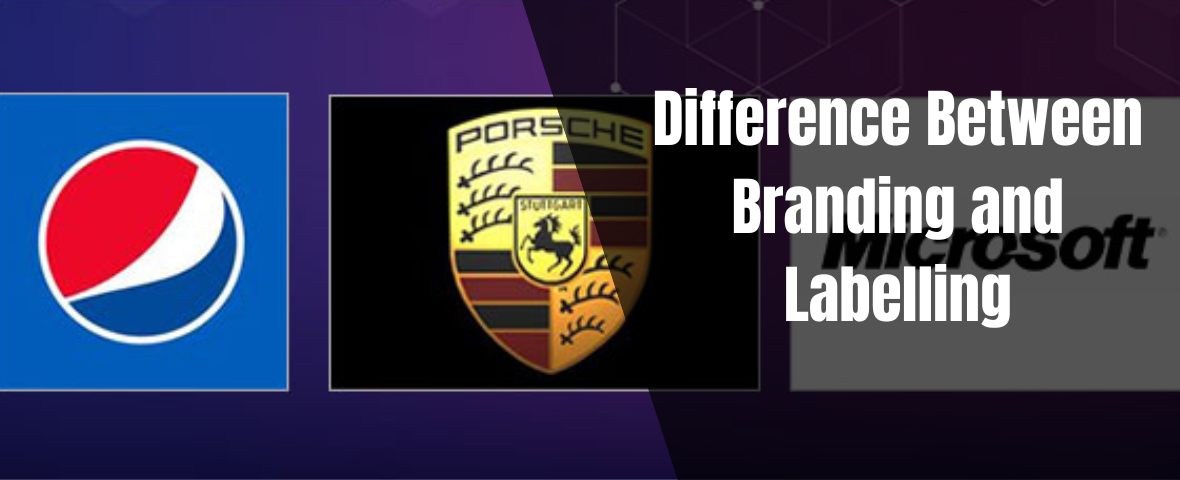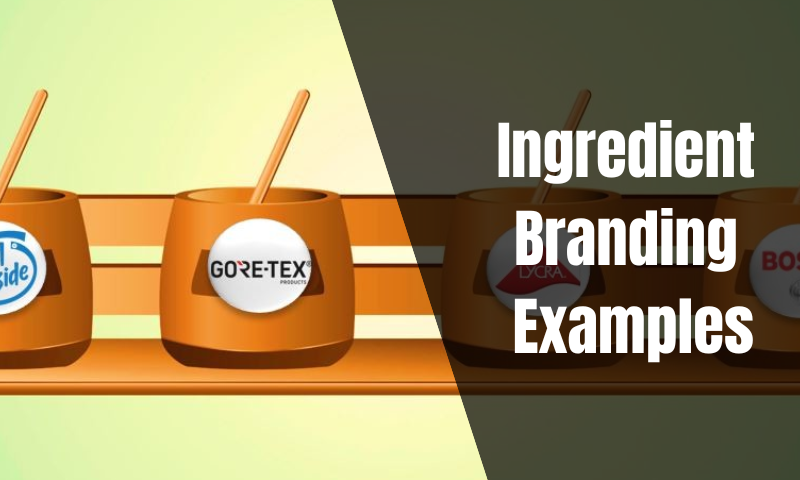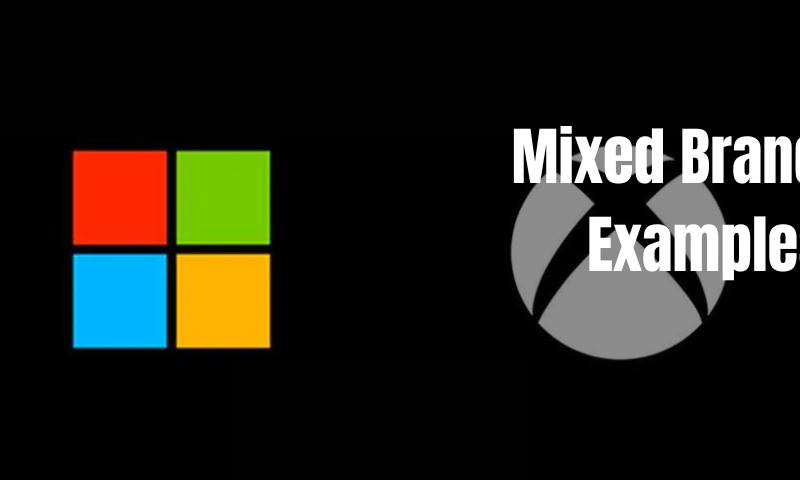
Difference Between Branding and Labelling
Key elements crucial in marketing and product presentation are branding, packaging, and labelling. These help companies in communicating their identity, differentiate their products and comply with regulations.
What is Branding
The process of creating a unique and identifiable identity for a product, service, or company is known as branding. It encompasses establishing a name, logo, slogan, and overall image that distinguishes a business from its competitors.
Branding aims to create an emotional connection with consumers and build brand loyalty. Successful branding can convey the values, personality, and promise of a company or product. It’s about how the public perceives and relates to the business or product.
While talking about branding, the next point of discussion is packaging. Packaging includes the design and physical container that holds a product. It serves multiple functions, including protecting the product, preserving its quality, and facilitating its distribution and handling.
However, packaging is also a crucial marketing tool. It can capture consumers’ attention, communicate the brand identity, provide information about the product, and influence purchase decisions. Effective packaging design takes into account aesthetics, functionality, and the target audience.
What is Labelling
Labelling is the use of labels or tags on a product’s packaging. This is done to provide information about the product. These labels usually consist of details such as the name of the product, the ingredients, nutritional information, usage instructions, safety warnings, and manufacturer information.
It is an essential element for the purpose of regulatory compliance and consumer communication. It guides and helps consumers in making informed choices and ensures that products adhere to legal and safety requirements.
In a nutshell, branding is about creating a strong and distinctive identity for a company or product, while packaging is the physical container and design that surrounds the product, serving both functional and marketing purposes. Labelling on the other hand is the information that is provided on the packaging to inform consumers and meet regulatory requirements. Together, these elements are vital in influencing consumer perception, purchase decisions, and overall marketing success.
Difference Between Branding and Labelling
Understanding the difference between branding and labelling is imperative for several reasons, particularly in the context of marketing and consumer communication. Let’s see a few of those reasons:
Clear communication: By knowing the difference, marketers can communicate in a clear and effective manner. Branding, as mentioned earlier, is about creating an overall identity and perception while labelling deals with the specific information and details about a product. Any kind of confusion regarding these two can lead to misunderstandings or miscommunication with consumers that can be detrimental to the company.
Consistency: Recognizing the difference can ensure that the company’s branding elements such as logos and slogans are used constantly across different product labels. In this regard, consistency is vital for building a strong and recognizable brand identity.
Consumer trust: Usually, labels contain important information about a product, such as ingredients, safety instructions, and usage guidelines. Hence, accurate and clear labelling eliminates any sort of ambiguity and builds trust with consumers. By bringing clarity, consumers can rely on this information to make informed purchasing decisions. However, misrepresenting this information can harm a brand’s credibility.
Legal compliance: Legal and regulatory compliance is extremely important in branding. Hence, to adhere to the regulation it is vital to have a clear understanding of the rules and guidelines. Products often need to adhere to specific labelling guidelines, especially in industries like food, pharmaceuticals, and cosmetics. Failing to do so can create legal issues, including fines and product recalls.
Consumer experience: An overall consumer experience is crucial for branding and it is done by creating an emotional connection with a brand. On the other hand, labelling helps consumers pilot through the practical aspects of a product. By separating these concepts companies can ensure that both the emotional and functional aspects of the consumer experience are properly addressed.
Market positioning: Establishing the brand’s position and image in the market is what we call branding. Meanwhile, labelling can reflect the specific attributes, features, or benefits of a product that make it stand out. Understanding this distinction allows a brand to effectively position itself in the marketplace.
Design and aesthetics: Both branding and labelling have design elements, but understanding their differences is crucial as it helps in creating visually appealing and functional packaging. It is mandatory that the design aligns with the brand’s image while presenting label information in a clear yet attractive way.
Recognizing the difference between branding and labelling is vital for effective marketing, legal compliance, consumer trust, and creating a seamless and cohesive brand experience. It allows businesses to strike a balance between the emotional and practical aspects of their products. Moreover, it ensures that all elements of the marketing mix work in harmony to achieve their objectives.
Since we have established that understanding the difference between branding and labelling is a must, it is time to look into those differences inaccurately.
First up is the purpose of the two elements.
Branding works with the primary purpose of creating a unique and memorable identity for a product, service, or company. It focuses on establishing a strong and emotional connection with customers, differentiating the brand in the market, and communicating the brand’s values and personality. For example, Coca-Cola’s branding aims to evoke feelings of happiness and refreshment, creating a strong emotional bond with consumers.
However, labelling is done to provide factual and essential information about a product. This information includes details such as ingredients, nutritional facts, usage instructions, safety warnings, and compliance with regulatory requirements. Take the company named The Nutrition Facts. Its label on the food product provides information about serving size, calories, and the amounts of nutrients, ensuring that consumers can make informed dietary choices.
Now let’s talk about what each element focuses on. The main focus of branding is to create a distinct and memorable brand image, evoke emotions and perceptions, and build brand loyalty. It often involves elements like logos, slogans, and overall brand identity.
Everyone knows about Apple’s branding which emphasizes innovation, sleek design, and a user-centric approach, making its products stand out in the tech industry.
The focus of labelling is on conveying factual and practical information as clearly as possible. It ensures that consumers have access to accurate and relevant data for making informed decisions and using the product safely. One good example is the warning label on a prescription medication that provides critical information about potential side effects and instructions for use, thus focusing on safety and compliance.
Now, what each of the elements has in terms of audience?
In branding, the audience is broad and includes potential and existing customers, stakeholders, and the general public. It aims to create a positive perception of the brand among a wide range of people.
Nike’s branding typically targets athletes and sports enthusiasts while promoting a message of inspiration and empowerment to a global audience.
The primary audience for labelling is the end consumers of the product. Labelling is specifically designed to provide product information to help consumers make informed choices and use the product safely. A noteworthy example is the ingredient label on a cosmetic product informs consumers with sensitive skin about potential allergens, helping them avoid skin reactions.
In short, branding focuses on creating an emotional connection with a broad audience to build brand loyalty, while labelling focuses on providing factual information to a specific audience to ensure transparency, safety, and informed decision-making.
Benefits of Branding
While talking about the difference, one must also look at the various benefits that branding and labelling offer to businesses. We will look into the branding and its benefits first:
Distinguishes from competitors: In today’s cluttered market, being unique and different is what makes a company ahead of the competition. Effective branding helps products or services stand out in a crowded marketplace. It distinguishes a brand from its competitors by conveying a unique value proposition, personality, and identity. This differentiation can be a key factor in attracting customers.
Enables customer loyalty: A strong brand that has established a positive image can foster customer loyalty. Customers who have a positive experience with a brand consistently associate it with quality, trust, and reliability. This makes them more likely to become repeat customers and advocates for the brand.
Increases brand awareness: A branding strategy that is well-executed definitely increases brand visibility and awareness. Further, it also ensures that the brand’s name, logo, and messaging are consistently and prominently displayed across various marketing channels, making it more recognizable to a wider audience.
Generates more sales: It is a gospel truth that businesses cannot run with sales. Thus, with effective branding, companies increase their sales. A strong brand identity enhances a product’s perceived value, thus making customers more willing to purchase it. Additionally, brand loyalty and awareness can drive customer preference which eventually leads to higher sales numbers.
Imposing premium pricing: Strong brands often have the ability to command higher prices for their products or services. Customers are often willing to pay more for a product associated with a trusted and well-regarded brand.
Supports marketing and advertising efforts: Effective branding provides a base for marketing and advertising campaigns. It allows for consistent and impactful messaging, making it easier to communicate with target audiences.
Attracts top talent and partnerships: A reputable brand has the ability to attract high-quality employees and potential business partners. People usually want to be associated with successful and respected brands, and this can benefit a company’s overall growth and success.
Expansion and diversification: A brand with a strong foundation can make it easier to expand into new markets or introduce new products and services. Customers who trust the brand are more likely to explore and try new offerings from the same company.
Business sustainability: A strong brand can contribute to the long-term sustainability of a business. It provides a foundation for growth, adaptability in changing market conditions, and the ability to withstand competition.
Benefits of Labelling
Branding, with its numerous advantages, is an essential aspect of a company’s overall marketing and business strategy. Having said that, labelling also plays an undeniably crucial role in providing valuable information to consumers and ensuring product transparency and safety. Here are the benefits of labelling for consumers:
Helps make informed buying decisions: As mentioned before, labelling provides consumers with essential details about a product, such as ingredients, nutritional information, pricing, and certification seals. This information empowers consumers to make informed purchasing decisions based on their preferences, dietary needs, values, and more.
Helps understand the risks and benefits of a product: Due to the warning labels and information regarding potential risks associated with products like side effects of medication, and allergens in food, it helps consumers understand the potential downsides and make choices that align with their health and safety concerns. On the flip side, labelling also highlights the benefits of a product to inform consumers about the positive aspects.
Helps use a product safely and effectively: Labelling includes guidance for usage, storage, and safety precautions as consumers must use the product correctly, avoid misuse, and ensure their safety. For example, medication labels provide dosage instructions, and food labels indicate cooking or storage recommendations.
Compliance with regulations and standards: Proper labelling is a legal requirement as it ensures that products meet regulatory and safety standards. This provides consumers with assurance that the product has undergone necessary quality checks and adheres to specific guidelines.
Transparency and accountability: Labelling fosters transparency in the marketplace. It holds companies accountable for the accuracy of the information provided to consumers. Honest and clear labelling practices build trust and credibility with customers.
Product traceability: Information on labels, such as manufacturing and expiration dates, batch numbers, and origin, can be crucial for product recalls or quality control. Thus, it serves as a means of traceability.
Ensures quality control: Labelling systems help businesses ensure product consistency and quality. Proper labelling procedures aid in avoiding errors and ensuring that the product meets specific quality standards.
Consumer empowerment: Labelling empowers consumers to align their purchases with their values and needs. Whether it’s a preference for organic products, avoidance of allergens, or choosing sustainable options, labels provide the necessary information.
Labelling is a vital component of consumer protection, information dissemination, and product safety. It enables consumers to make informed choices, understand product risks and benefits, and use products safely and effectively while also ensuring that products meet regulatory standards and comply with transparency requirements.
Tips For Using Branding
Now that the benefits are clear, marketers must make sure that the branding is effectively done as it is essential for building a strong presence and connecting with the target audience. Here are some tips for using branding successfully:
Strong brand identity: Developing a clear and compelling brand identity that reflects the company’s personality, values, and mission is a must. This encompasses defining the brand name, logo, colour palette, typography, and visual elements. The brand identity should be memorable and resonate with the target audience.
Consistency: Consistency is key in branding. Ensuring that the brand elements and messaging are the same across all platforms. A consistent brand image builds recognition and trust, while any disparity can create harmful effects.
Communication of brand values: Brands need to communicate their values and what they stand for. This could involve supporting social causes, emphasizing product quality, or promoting sustainability. However, it must be authentic as consumers appreciate brands that live up to their stated values.
Build relationships with customers: Brands should engage with the customers to foster meaningful relationships. This can be done by responding to feedback, providing excellent customer service, and creating experiences that align with the brand identity. Social media, email marketing, and personalized communications can help build customer loyalty.
Telling the brand story: Another important tip is to share the brand’s story with the audience. This can be achieved by explaining how and why the brand was founded, its journey, and the people behind it. A compelling narrative can create an emotional connection with customers that will be greatly beneficial for the brand.
Be different: Highlighting what sets the brand apart from the competition goes a long way. Identifying the unique selling points (USPs) and emphasizing them in the branding efforts can create differentiation thus ensuring the brand is more attractive to consumers.
Know the target audience: It cannot be stressed enough how important knowing the target audience is. Conducting market research to gain a deep understanding of the target audience’s needs, preferences, and pain points can help brands tailor their branding strategies that resonate with the specific customer base.
Adaptability to new trends: Being complacent and ignorant about the new changes in the market can cost brands dearly. Thus, staying current with industry and market trends and being ready to adapt to those changes is crucial. This will make the branding efforts relevant and appealing to the audience. This can involve modernizing the brand image, adopting new technologies, or aligning with emerging customer values.
Evaluate brand performance: Continuously assessing the impact of the branding efforts is important. It will help brands to make necessary changes as per the requirement. Using key performance indicators (KPIs) to measure brand awareness, customer loyalty, and overall effectiveness and adjust the strategies based on data and feedback is an extremely helpful and effective way to operate.
Brands should remember that branding is a continuous process, and it should evolve as the business grows and the market changes. Consistent, well-executed branding can help establish a strong presence in the industry and connect with the target audience effectively.
Tips for effective labelling
Labelling is another critical aspect of product presentation and compliance. Here are some essential tips for effective labelling:
Be clear and concise: Time is a luxury that consumers these days don’t have enough. Hence, brands should make sure that they use clear and easy language and avoid jargon or technical terms that may confuse consumers. Clear communication of the necessary information in a way that is easily understood is greatly appreciated by consumers.
Use plain language: It is always better to go for simple and easy-to-understand language. This ensures that consumers of various literacy levels and backgrounds can grasp the information provided.
Include all relevant information: All labels must contain every necessary detail about the product. This may include ingredients, usage instructions, nutritional information, allergen warnings, safety precautions, expiration dates, and any other information relevant to the product’s use or consumption.
Prioritize safety information: Safety warnings and usage instructions should be prominently displayed, especially for products that could pose risks if not used correctly. This is crucial for products like medications, chemicals, and potentially hazardous items.
Ensure readability and legibility: A font size and style that is easy to read should be used. Hence, marketers must consider factors like contrast, font colour, and background to ensure the text is clear and legible. Also, the most critical information should be easily noticeable. It is suggested to run a test to assess the legibility of the texts.
Regulations and standards adherence: Labels must comply with legal requirements and industry standards. This includes accurate information, appropriate formatting, and compliance with specific labelling regulations in the industry. If there is uncertainty about labelling requirements, then consulting with legal experts or regulatory professionals who are knowledgeable about industry-specific labelling regulations is highly recommended. It is always better to be safe than sorry.
Multilingual labels: If a product is intended for an international or multilingual audience, considering labels that are in multiple languages ensures that all consumers can understand the information.
Include contact information: Labels should have the contact number of the company in case consumers have questions or concerns about the product. This could be a customer service hotline or an email address.
Regular review and update labels: Labels should be current with any changes in ingredients, formulations, or regulatory requirements. Regular reviews also allow companies to make improvements for clarity and effectiveness.
Speaking about the Indian market space, a multitude of creative agencies in Gurgaon, Delhi, and various other cities across India, specialize in providing labelling solutions for a wide array of industries. These agencies excel in designing visually appealing and informative labels that comply with legal requirements while strengthening brand identities. Their expertise extends to diverse sectors, offering innovative design, messaging, and compliance strategies to ensure products are not only safe but also uniquely positioned in the market, fostering consumer trust and loyalty.
Therefore, it can be said that branding and labelling are distinct but interconnected elements of marketing and product presentation.
While branding focuses on creating a unique and emotional connection between a product, service, or company and its target audience, labelling is the provision of factual and essential information about a product that includes details such as ingredients, usage instructions, safety warnings, and compliance with legal requirements. Both play a vital role in consumer decision-making and contribute to a brand’s overall success and reputation in the marketplace. Therefore, understanding the distinction between branding and labelling is crucial for businesses to effectively communicate their brand identity while providing consumers with the necessary information for informed and safe product usage.



